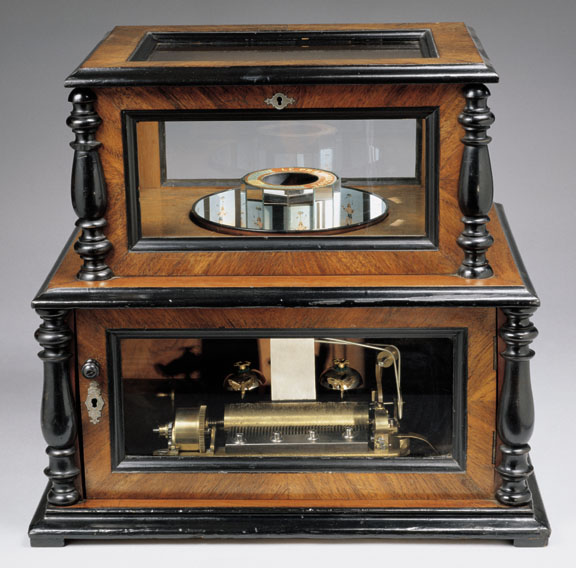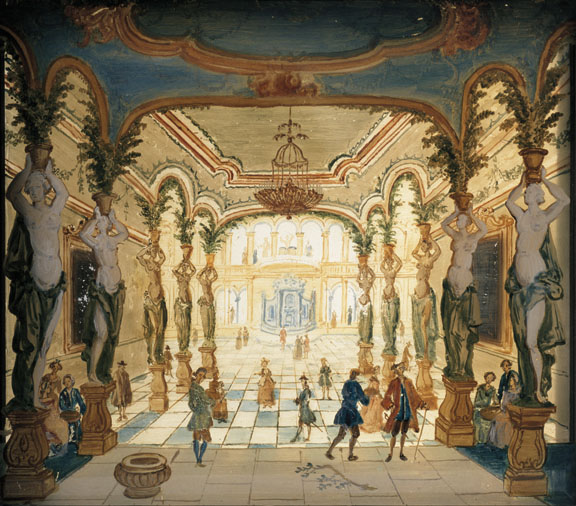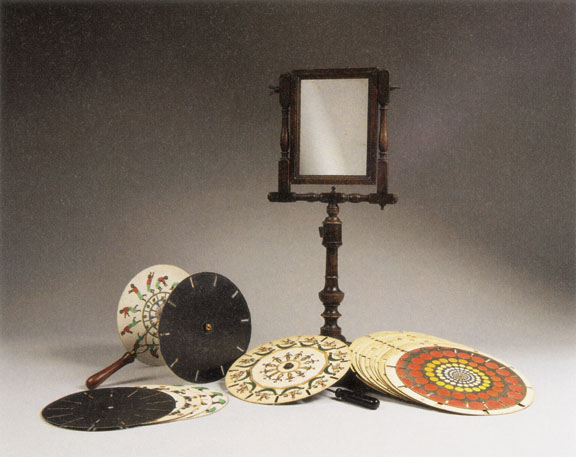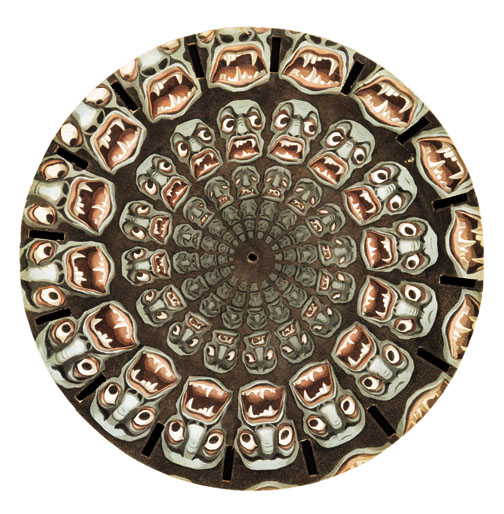Glossary P
A - B - C - D - E - F - G - H - I - J - K - L - M - N - O - P - Q - R - S - T - U - V - W - X - Y - Z
Peep Show
Also known in English as 'peep box'.
Early versions of the peep show first emerged during the Renaissance, the age that also first recognised the laws of fixed-point perspective.
The new perspectival views opened up hitherto unknown spatial depths to the beholder. One of earliest descriptions of a peep show appeared in 1677, in Neu-erfundene Mathematische und Optische Curiositäten (Newly-invented Mathematical and Optical Curiosities) by the Coburg professor of mathematics Johann Christoph Kohlhans (1604–77).
From the early eighteenth century onwards, showmen used to travel the land with their peep shows. At annual fairs and folk gatherings, people would pay to see the wonders in the box, the drama further heightened by the showman’s commentary. In more affluent circles, the peep show became a popular device for discovering other worlds. The strange mixture of magic and reality ensured the long-lasting popularity of the peep show.
A special variant of the peep show is the ‘perspective theatre’, replicating in miniature a theatrical stage. Up to seven interchangeable sets with cut-out figures are placed one behind the other in the peep box. These spatial sets were mainly made in eighteenth-century Augsburg by Martin Engelbrecht (1684–1756).
The zograscope is a vertical, skeletal type of peep show. It consists of a stand, the height of which can be adjusted, a large, vertically-fixed convex lens and a sloping flat mirror. The inverted images in the camera obscura were righted again by this device. In the nineteenth century, a simplified peep show was developed in the shape of a folded, paper diorama, which could be expanded like an accordion.
Phenakistiscope
[Greek: phenakizein = to deceive by false reflections; skopeô = to look, to see]
Also known as a ‘wheel of life’. Sold as the ‘fantascope’ in Britain from 1833 onwards.
Device that allows drawn sequential images to be perceived as movement.
Based on the principle of the Afterimage, the phenakistiscope was developed in 1832 by a professor of anatomy and physics in Ghent, the Belgian Joseph Plateau (1801–83). It consists of a handle to which is attached a disc that can be rotated. At the edge of the disc there are a number of radial slits. In order to create the effect of movement, the disc has to be rotated in front of a mirror, with the viewer looking into the mirror through the slits, so that the sequential images are perceived as a moving picture.
At the same time, Simon Stampfer (1792–1864), professor of practical geometry in Vienna, was also constructing a version of phenakistiscope discs called stroboscopic discs. A later development of the original 'wheel of life' obviated the use of a mirror: now the slits and the sequential images were on two separate discs linked to a single axle. The viewer looks through the slits in one disc at the images on the other.
Physionotrace
Also known as a silhouette machine. A drawing device that combines three portrait techniques: the outline drawing of the silhouette maker, the pantograph used for enlarging or reducing an image, and copper engraving.
In 1776 Johann Caspar Lavater (1741–1801) built his ‘silhouetting chair’. If a person sat on the chair in darkness between a burning candle and a screen, their shadow would be cast so sharply onto the screen that its outline could be traced with complete accuracy. Presumably Lavater was the inspiration for the invention by the Frenchman Gilles-Louis Chrétien (1754–1811) in 1786 of a device that facilitated the rapid, inexpensive production of hundreds of portrait silhouettes.
In contrast to Lavater’s silhouetting chair, which still required the image to be drawn by hand, the physionotrace was much less demanding. First the operator would train a sighting device on the profile of the sitter’s head. The cross thread and the burin were connected via a so-called ‘stork’s beak’, so that the outline could be proportionately reduced as desired and engraved or etched in copper.
The principle applied here draws in part on an already extant perspective machine: the pantograph with sighting device made in 1603 by Christophorus Scheiner (1573–1650). After its invention, the physionotrace was initially only popular in France; later it spread to the USA and Britain before it was finally ousted by the daguerreotype.
Praxinoscope
[Greek: praxis = to do, to act; skopeô = to look, to see]
A viewing device where a sequence of images is seen in a centred polygonal circle of mirrors.

Developed in 1877 by the French professor of natural sciences Emile Reynaud (1844–1918) this device is an improvement on William George Horner’s Zoetrope, because it has no sight slits and hence no dark phases. The images are placed on the inner wall of a rotating drum; their number corresponds to the number of flat mirrors that are set next to each other in a circle in the centre of the drum.
The transition from one image to the next occurs imperceptibly because the second image merges laterally into the first, before completely replacing it. In 1888 Reynaud improved on his own projection praxinoscope, which already projected glass images, and created his théâtre optique (optical theatre), which he then used for public presentations of his pantomimes lumineuses (illuminated pantomimes). A magic lantern projects a static stage set, for instance a landscape painted on a glass plate, and a second lantern projects translucent picture strips with moving figures or actions into this set.
Puzzle Pictures
Ambiguous images that can only be identified on close observation. These include images that switch from one thing to another, images that one has to peruse in detail, and optical illusions.

Amongst the oldest optical illusions are Albrecht Dürer’s (1471–1528) rock faces and Giuseppe Arcimboldo’s (1527–93) paintings of flowers, fruits and vegetables. In the seventeenth and eighteenth centuries, there was a fashion for anthropomorphic or zoemorphic landscape scenes which, if rotated through 90°, would apparently turn into a human being or an animal. A notable exponent of this form was Matthäus Merian (1593–1650); in 1646 Athanasius Kircher (1602–80) included an anthropomorphic landscape by Merian in his Ars Magna Lucis et Umbrae (The Great Art of Light and Shadow).
Other optical illusions, which can be rotated through 180°, turn young into old, a man into a woman, human into animal, and so on. These ‘turning head’ illusions were often made to mock a figure of authority.



